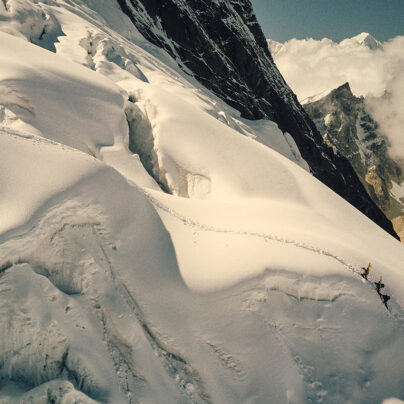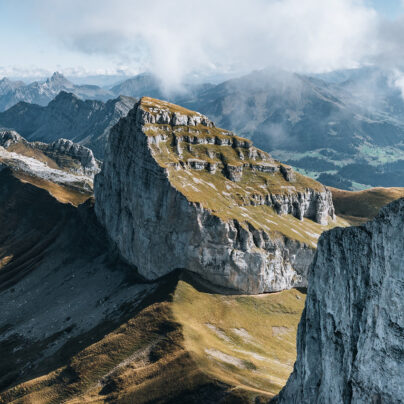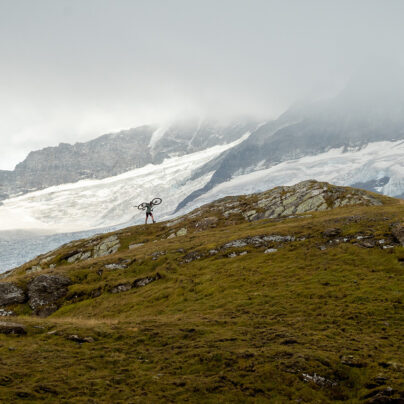Himalayan Backcountry
A Journey Through Eastern Bhutan
Michael Marquand
While hiking up the trail to Merak, my breathing becomes laboured. The shift in altitude is noticeable and suddenly the equipment strapped to my back feels heavier.
While hiking up the trail to Merak, my breathing becomes laboured. The shift in altitude is noticeable and suddenly the equipment strapped to my back feels heavier. I have been in Bhutan for a few weeks already, and I thought I had gotten used to the thin air. But now, we are higher and I am adjusting to the second wave of it. Not only are we at higher altitude, but it’s much colder. It’s also snowing and the further up the trail we get, the more snow I see on the ground.
Merak is a small village in the Trashigang district in Far East Bhutan, inhabited by the Brokpa (which translates to ‘highlander’) people. Eastern Bhutan is very rural by nature and design, but this is one of the only villages in the country not accessible by a road.
Partway up the trail, we pass a friendly middle-aged couple carrying bags. I can tell they are Brokpa, the Merak natives, because the woman is wearing a hat I’ve only seen in photographs: a kind of beret with tails made of yak wool sticking out of the bottom, so that the raindrops and wet snow can collect and fall off the tips. This is actually a brilliant invention if you live in a culture full of wool and devoid of plastic ponchos. Their faces are attractive with a strong weathered character, perhaps as a result of the climate and altitude. The couple smile as they pass us, hoisting their large bags over their shoulders. I assume they are going to get supplies at the tiny roadside shop at the end of the trail – the main access point to the rest of the world.
As I head further up the trail to the first mountain peak, the geography opens up to me in the most dramatic way. I can see everything – large rolling mountains covered in snow and pine trees. The dramatic vistas are complemented by the late afternoon sunlight peeking in through the clouds. The air feels cooler and it’s the first time I’ve been privy to this much wide open space in days. Yaks wander over the crest of the hill and through the village, a snow-covered huddle of small wooden houses where children play in the distance. The whole environment seems to have come to life.
I walk around the village and see young children and a handful of adults crow around a hillside fire. Their cheeks are red from the cold, but they seem to be used it. Further along, a group of adolescent boys practise archery, dressed in a mixture of second-hand Western clothing and local handmade wool and yak fur. They shoot arrows with hand-carved wooden bows and hit targets at remarkable distances. As I’m watching this charming practice session, two Bhutanese men lead a herd of yaks over the hill behind us. As they pass me by, I can hear the yaks huffing up the hill, against a backdrop of snow-covered pine trees. The whole scene is so idyllic that it feels like a film set. I would come to learn that this can be said for much of Bhutan.
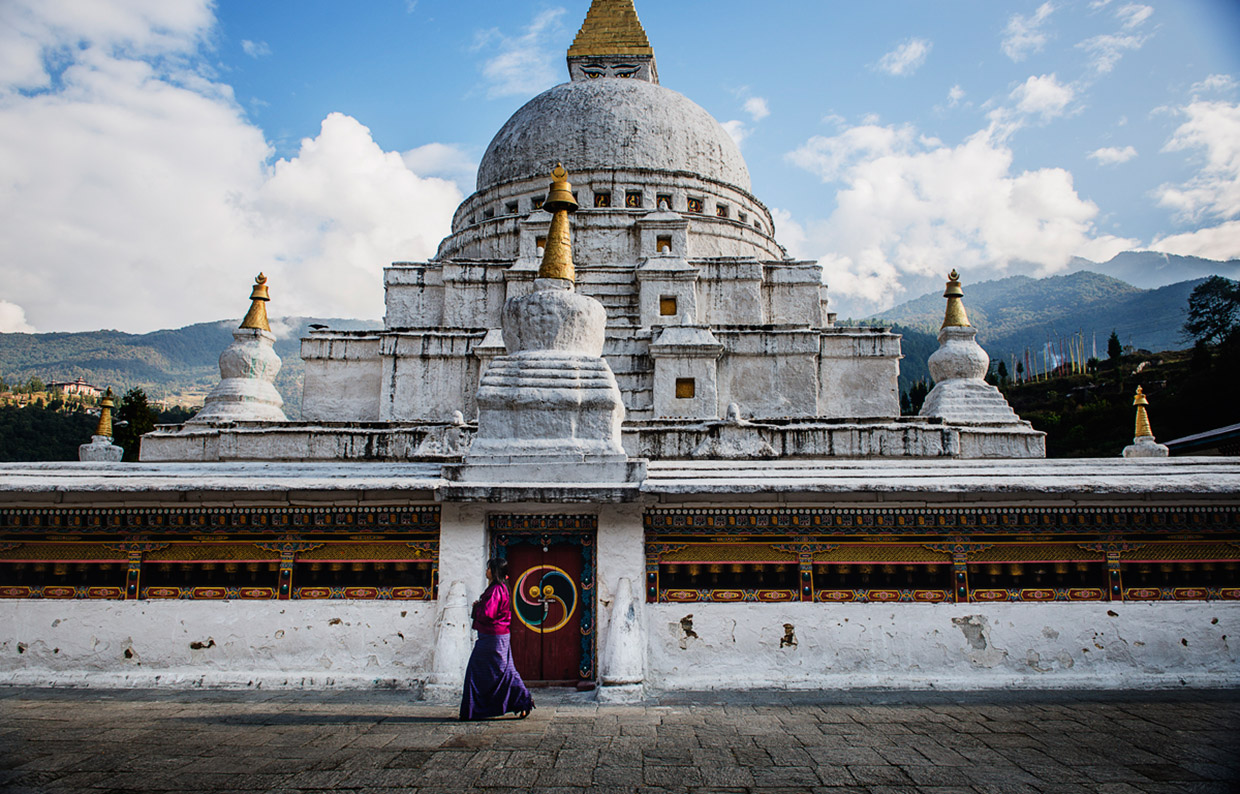


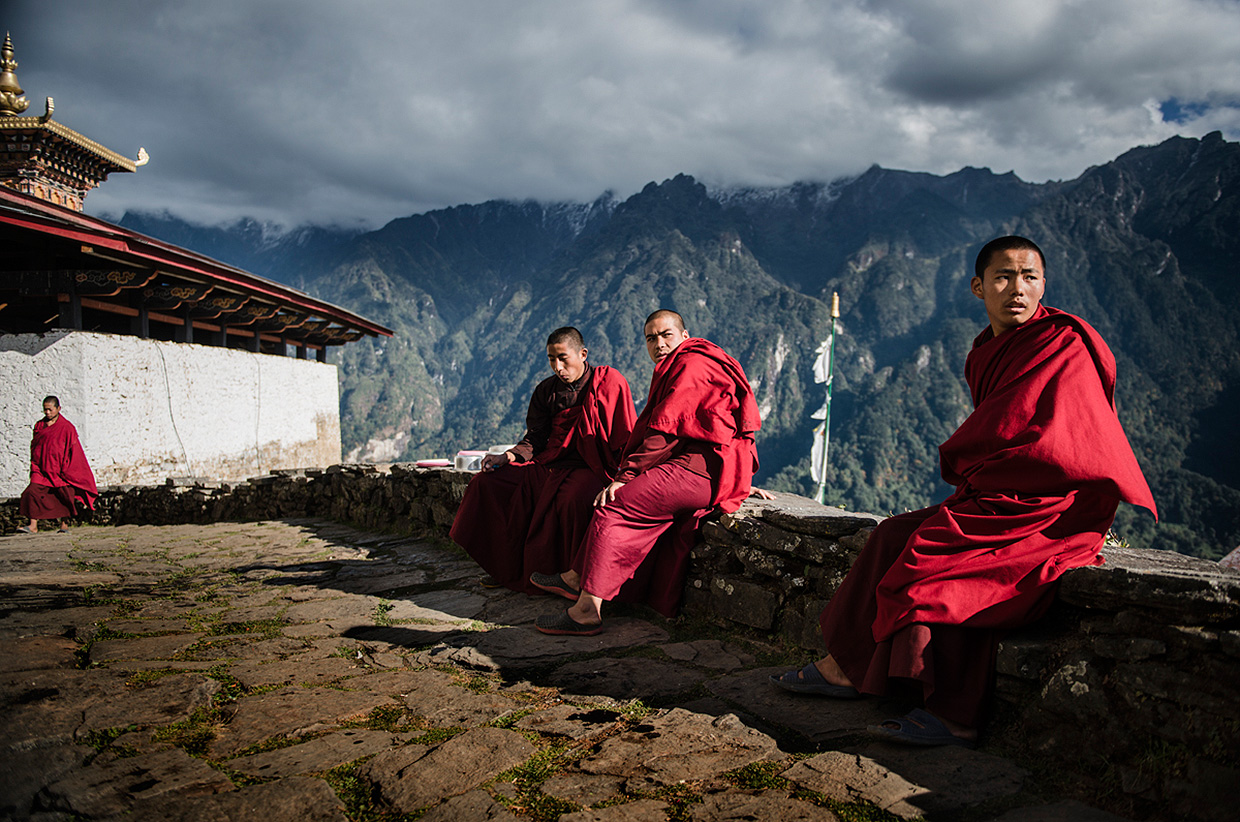
I spent two months travelling through this small Himalayan country, along with two others. Signe, a young woman from Denmark, has been coming to Bhutan for years. Remarkably, she seems familiar with everything about the country and yet still in awe of it at the same time – a testament to its natural wonders. Vince, a New Yorker, is as impressed and foreign to the place as I am. Both Signe and Vince are animated and entertaining, an ideal combination for a trip filled with unknown adventures. Our downtime activities alternate between Signe recounting the mythology behind the local Chorten or the ceremonies we witnessed that day, and Vince’s over-the-top impressions of his Italian mother from Brooklyn.
One of our first destinations – and one of my favourite spots – is the town of Gasa. On arrival, we hike up to the town Dzong – a Buddhist monastery and fortress – built into a mountaintop, where we spend the afternoon with a group of friendly monks (and sans any tourists). As we walk around the Dzong, we see various monks adorned in blood-red robes doing construction, cooking, cleaning, and sometimes praying. They have a calming and cheerful presence about them, perhaps as a result of centuries of meditation.
While I observe the Dzong’s inhabitants they seem equally curious about me. They look at me with soft eyes and bold stares interwoven with subtle grins and a hospitable affability. One such monk takes us into the kitchen and boils water for our tea and lunch of Maki noodles (dried prepacked noodles sold everywhere in Bhutan and a staple for days like this as they provide plenty of calories without adding weight to our packs). One young boy approaches as I take his picture. He is clearly the youngest monk at the Dzong, possibly the youngest monk I’ve ever seen. He looks at his photo in the camera, smiles and then asks to try on my sunglasses. He seems overjoyed by this new social dynamic and can’t get enough of our attention. The boy enthusiastically proceeds to give us a tour of the Dzong. The architecture, like most religious structures in Bhutan, is built from stone and wood decorated with boldly coloured ornate fabric and metals, and the interiors are filled with ancient relics, traditional masks, and detailed illustrations of Buddhist gods. Our walk ends with a cliffside view overlooking the valley where we’d be spending the evening.
Later in the evening, we decide to relax in the local hot springs. The springs originate from the mountain and funnel into different pools of varying temperatures. Each pool sits under an open-air rooftop that helps contain the steam and heat. We get into the mildest of pools and feel the hot water seep in while the cold breeze flows in from the river nearby. After some time, we graduate to a hotter spring. Drinking a large Druk beer, I find myself sitting between a heavy-set topless woman breastfeeding her baby to my right and a young monk performing deep-throated, guttural meditation chants to my left with only the mist rising off the water to separate us. Vince, seated across from me, appears to be the only person who recognises the absurdity of the situation. He laughs and curses himself for not bringing his camera. As unexpected as the moment felt, I only had a small taste of the country so far and was unaware of the depth and range of experiences to come.
The Dzong’s inhabitants look at me with soft eyes and bold stares interwoven with subtle grins and a hospitable affability.
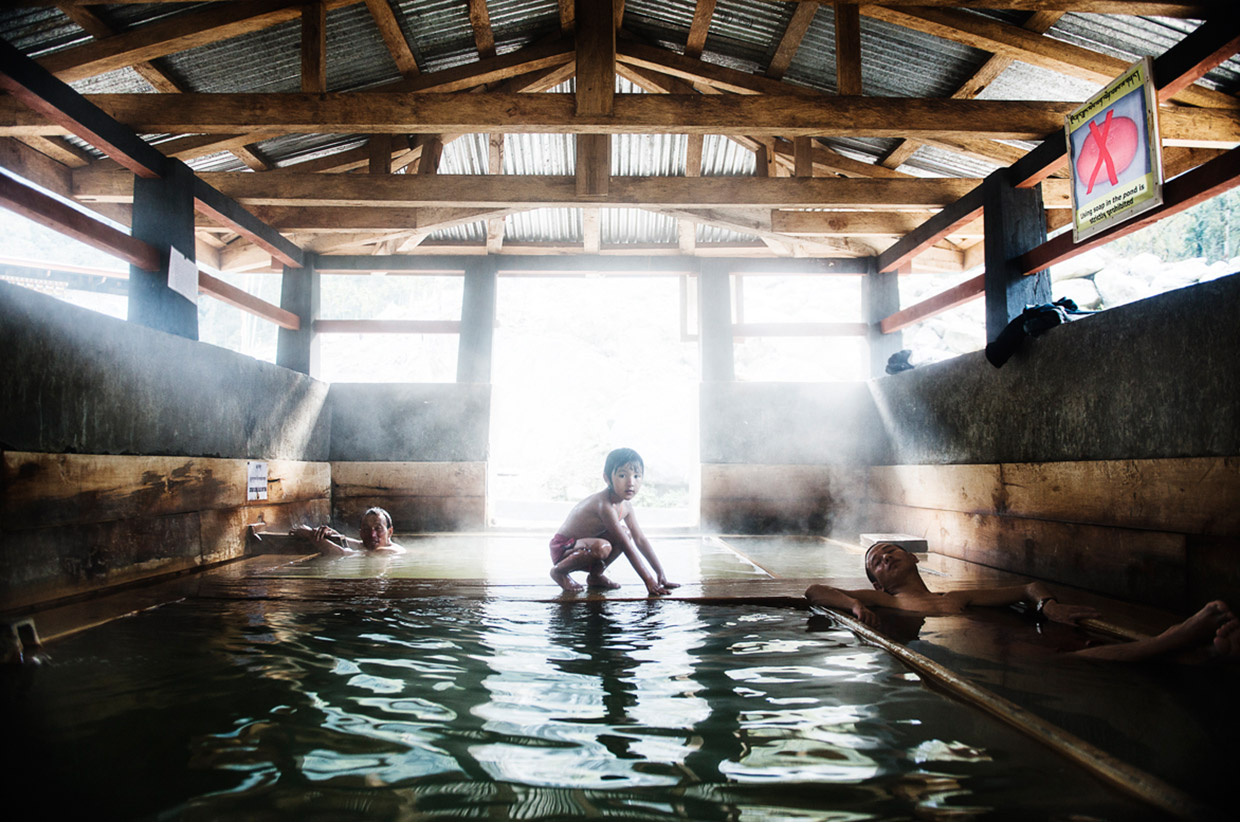


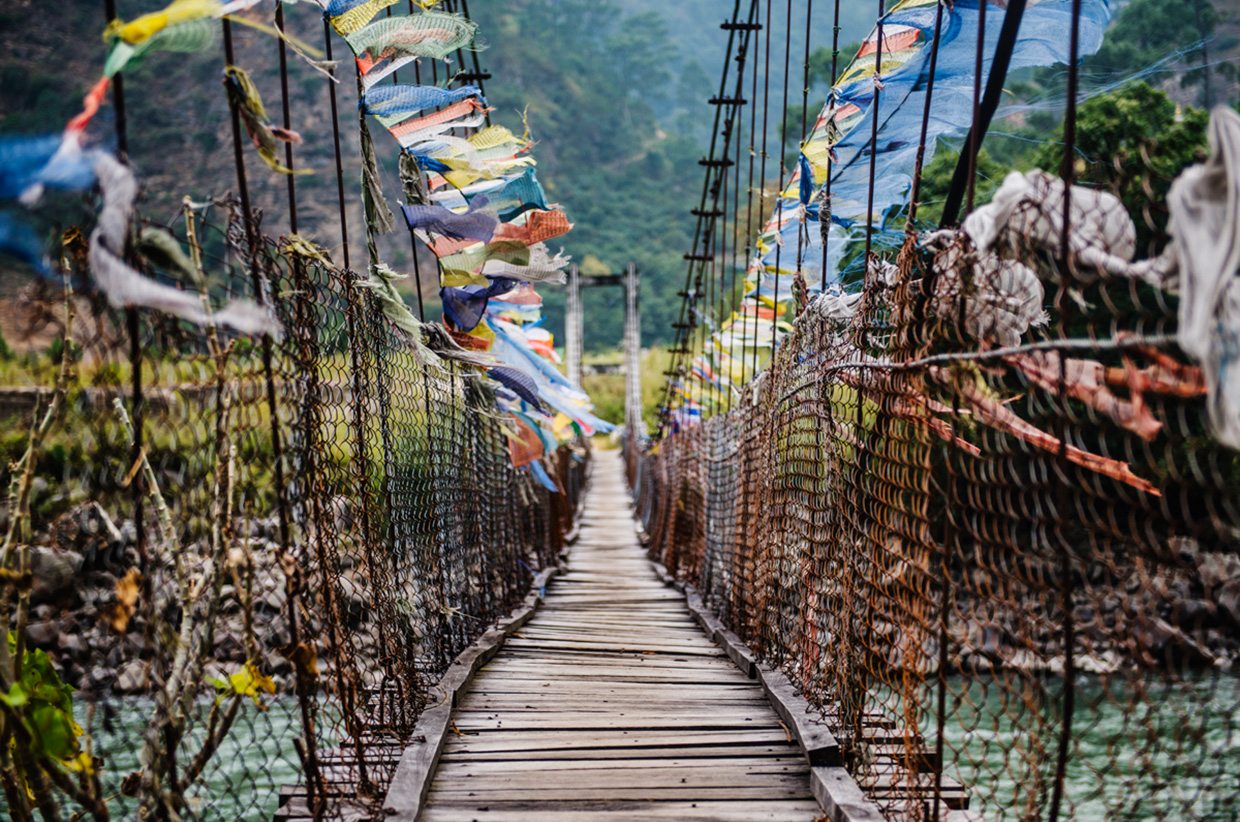
The architecture of these farmhouses is beautiful and raw – a pleasant departure from the sterility of modern city life. The houses are made of wood, with colourful hand-painted patterns and images of deities, and they sit in the farmland amongst trees and cattle.
In between our treks, we would often stay in farm houses. For a small sum of money, we could buy a place to sleep and a meal, as much tea as we could drink, and the chance to interact with and observe our host family.
The architecture of these farmhouses is beautiful and raw – a pleasant departure from the sterility of modern city life. The houses are made of wood, with colourful hand-painted patterns and images of deities, and they sit in the farmland amongst trees and cattle. The lodgings are usually simple: a wooden floor with blankets and a pad that vaguely resembles a mattress. The meals, however, are supreme. At lower altitudes, we are given fresh food the like of which I have never tasted before. One farmhouse in Mongar gives us oranges, guava and avocados, to mix with our homemade curry, eggs and red rice – all grown on the property. It’s a much-needed breakfast after a sunrise hike through the forest to the local ruins. The higher altitudes have mostly dried foods that are still as tasty. The farmhouses in Phobjikha and Trashiyangtse hang dried turnip leaves over the fire and the women of the village take a few each night to throw into a curry. Nearly every farm dries peppers, arguably the most important ingredient to Bhutanese cuisine, on their rooftops (or any other available outdoor surface), so they can be eaten year-round. Every household in which we stay serves Ema-datsi, a dish made of chili peppers and cheese. Depending on the region, this dish has innumerable variations: the peppers can be dried or fresh, and red, green or white with varying degrees of spiciness, or swapped out entirely for mushrooms. The cheese can be a thin milky sauce, a thick yak cheese, or anything in between. Another common dish is momo, a Tibetan dumpling filled with meat or vegetables, buckwheat noodles and pancakes, a fusion of curries, various noodle and potato dishes with well-spiced vegetables. This dish is an amalgam of influences from Indian, Chinese, and Nepali cuisines. In the evenings the food is paired with ara, a clear homemade liqueur made from rice, millet, maize or wheat./p>
Aside from the obvious comforts of such cuisine, our best domestic experience is in the village of Phobjikha, the home of the Black-Necked Crane Festival. The festival gets its name from the migratory patterns of the black-necked cranes which fly in from Tibet during the winter months. The two children in the home at which are staying, a boy and his younger sister, speak English and willingly translate for their parents and grandfather. And after some questioning, the two children shyly tell us about their favourite subjects in school. Eventually we find them both eyeing a jar of Nutella peeking out of Vince’s bag. He tosses it to them and says, ‘have at it,’ which quickly produces two huge smiles before they take the jar and disappear.
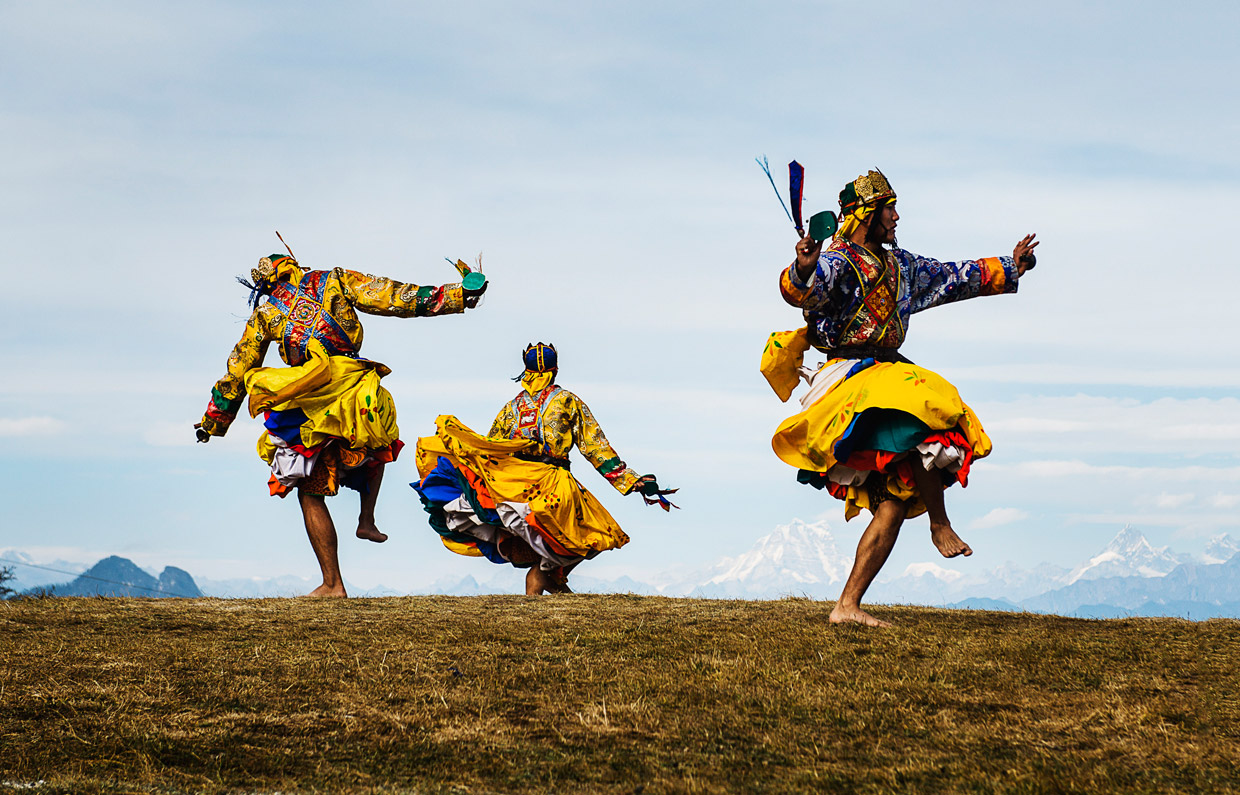
The next afternoon I run into the same boy, in full costume, right before his performance at the Black-Necked Crane Festival. He nervously comes up and says hello and it takes me a minute to recognise him. I hadn’t realised until this moment that he was performing in the festival. And when I see how many children are getting ready, it strikes me that almost every kid in Phobjikha is probably here performing some sort of ritual to celebrate the return of the birds. Nearly the whole village is present, making the ceremony feel like a small-town county fair built on centuries of tradition.
A day later, while walking around Phobjikha, we manage to see a couple of actual black-necked cranes in a field near the village. We keep our distance, because the area in which they are feeding is protected and forbidden, but we manage to walk through a muddy field, full of wild horses, in order to get a better view. Eventually the cranes fly away and our collective attention turns to the horses. They’re shy and skittish, and we are never able to get too close to them either, but it is enough to witness these animals in a wide open field of pure orange and gold tones.
Throughout the rest of my stay, I would often spot wild horses in the distance. Their vague shapes would become a common decoration of the landscape. But I would never get any closer to them than this moment in the field. The horses make fitting characters for Eastern Bhutan. Like the monks, cranes, yaks, and Brokpas they are elusive, intriguing and uniquely Bhutanese. Looking out onto Phobjikha valley I know that I’ll be back some day, and hope that I’m able to experience the uncorrupted beauty and seclusion of the Himalayan kingdom once again.
Read more from this journey in our story from Signe and Michael in Sidetracked Volume Five
Michael is a commercial and editorial photographer from Seattle, Washington. However, he’s been living in New York and working in the city’s photo industry for almost a decade. His photographs are defined by graphic compositions, natural daylight, and a strong use of color, with a body of work that includes a focus on travel, people, interiors culture and food. His work has been published in Conde Nast Traveler, Lonely Planet, Wine Spectator, Vanity Fair and l’officiel voyage among others. Michael recently spent two months working and traveling through Bhutan.
Website: marquandphoto.com
Instagram: @mmarquand
LinkedIn: /michaelmarquand
Google +: +MichaelMarquand




